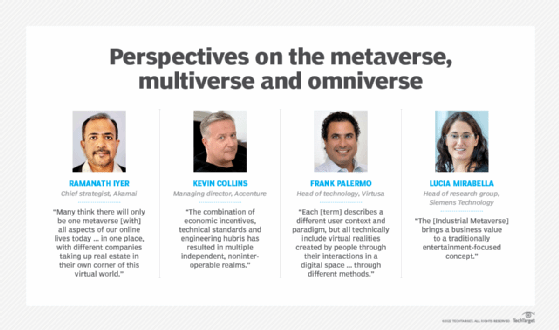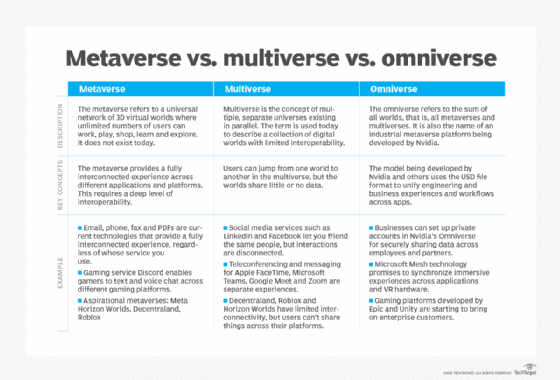Metaverse vs. multiverse vs. omniverse: Key differences
Virtual realities are coming to a computer interface near you. Will you be joining a metaverse, multiverse or an enterprise-oriented version of the omniverse?
As interest in the metaverse continues to surge, discussion about the terminology used to describe the concept of immersive 3D, digital environments has also picked up steam. Three terms -- metaverse, multiverse and omniverse -- are sometimes used interchangeably, but they take different approaches to virtual reality.
"Each describes a different user context and paradigm, but all technically include virtual realities created by people through their interactions in a digital space. However, they accomplish it through different methods," explained Frank Palermo, executive vice president and head of technology at Virtusa, a digital engineering consultancy. The following outlines the basics:
- Metaverse implies a level of deep interoperability across worlds and platforms in which assets and characters flow from one to another.
- Multiverse contains multiple independent worlds that share little, if any, data. Examples include two games with different rules, equipment, sign-in systems and friends lists.
- Omniverse could refer to the sum of all worlds or, when capitalized, to a specific industrial metaverse platform from chipmaker Nvidia.
Let's dig in.
Metaverse vs. multiverse vs. omniverse
Kevin Collins, managing director at Accenture, explained that the original vision for the metaverse was one continuous, embodied digital space. Think of it as a digital space where specific rules apply universally around identity, ownership and technical specifications. However, that's not how it's panning out so far, Collins said.
"The combination of economic incentives, technical standards and engineering hubris has resulted in multiple independent, noninteroperable realms," he said.
In other words, the current so-called metaverse is a multiverse, a collection of metaverses with some level of interoperability. Examples include gaming platforms like Decentraland, Roblox and Horizon Worlds.
The omniverse includes all metaverses and multiverses, whether they are interoperable or not. "There is only one omniverse, and it includes everything," Collins said.
Nvidia's Omniverse is trying to include everything through a novel approach to interoperability. We cover that in more detail in a bit, since the approach is generally more applicable to the enterprise than consumers. It's also worth noting that other 3D platform providers, including Microsoft, Epic and Unity, are trying to do something similar -- without the cool name.

Metaverse
Neal Stephenson coined the term metaverse in his 1992 novel, Snow Crash, to describe a single interconnected virtual world and economy. This original conception is cited as a critical element in many descriptions of the term today.
"Many people think there will only be one metaverse and that this new space will include all aspects of our online lives today -- gaming, shopping and social, all in one place, with different companies taking up real estate in their own corner of this virtual world," said Ramanath Iyer, chief strategist at Akamai, a content delivery network services provider.
Proponents imagine that new decentralized trust mechanisms, such as cryptocurrencies and non-fungible tokens, will make it easier to move assets, avatars, items and other things across virtual worlds that are connected within a larger metaverse.
Multiverse
The idea that there are multiple universes has existed since ancient times and been considered by thinkers in many fields, including physics, cosmology, religion and literature.
Now, people are extending the concept that we live in a web of interconnected, parallel, physical realities to describe how multiple digital worlds or fragmented metaverses may be woven together or operated in tandem.
Most people, it seems fair to say, probably have not met anyone who has jumped between physical worlds. In the virtual world, the notion does not seem as farfetched, Palermo said.
Palermo sees the digital multiverse as separate experiences that could be virtual or even 2D web experiences. He cites interactions you have with the same person on different platforms -- Facebook, TikTok or a 3D Xbox game -- as an example of participating in a digital multiverse.
The rub is that you cannot easily connect identities, groups or discussions between these separate environments. Indeed, this is one of the significant shortcomings of traditional walled-garden architectures that do not connect. A significant advantage is that these siloed platforms can better control privacy and security than decentralized approaches.
Nvidia's Omniverse
Nvidia co-opted the term omniverse to describe its specific approach to integrating industrial digital twins at scale using the Universal Scene Description file format. The company has been busy developing connectors to all the major 3D engineering, design and entertainment apps that enable participants to work away on the same file. In the traditional workflow, someone exports a file to view in another app, and a lot of manual effort is involved in keeping different versions in sync.
Nvidia's approach has been to connect these industrial design tools at the file level. A change in one tool is instantly visible across all other tools connected to the platform. Nvidia, in concert with Siemens, has recently begun calling this the Industrial Metaverse since it unifies the immersive experiences of enterprise design tools.
"This brings a business value to a traditionally entertainment-focused concept," said Lucia Mirabella, head of research group at Siemens Technology.
Meta's metaverse vs. Nvidia's Omniverse
Meta and Nvidia broadly describe two different approaches to the metaverse, each of which plays to their respective strengths:
- Meta's metaverse vision takes advantage of its strengths in supporting a massive online consumer social media platform.
Meta describes the metaverse as "the next evolution in social connection and the successor to the mobile internet," claiming its version of the metaverse "will allow you to get even closer to the feeling of being together with others." Users will be able to live, work, play, shop and learn in a massive, shared 3D space. The company has said it hopes to reach 1 billion people in the metaverse in the next decade.
- In contrast, Nvidia's Omniverse builds on its strength in industrial AI, training robots at scale, building medical equipment and high-performance rendering.
Nvidia describes its Omniverse as an extensible platform that enables "individuals and teams to build custom 3D pipelines and simulate large-scale virtual worlds faster than ever." Nvidia is also developing an ecosystem and marketplace for selling best-of-breed expertise in tools, AI models, simulation models and business workflows to other enterprises.

The future of metaverse, multiverse and omniverse concepts
What's the takeaway for business in this hairsplitting exercise? Enterprises must consider how interoperability -- or lack thereof -- aligns with their business goals and technical capabilities. The metaverse suggests a path toward greater interoperability, while the multiverse's closed approach could be essential for protecting competitive advantage.
Collins said greater interoperability provides better UX, with universal interoperability being the optimal scenario. However, there are financial incentives to keeping users in a walled garden or at least to creating some interoperability friction. He suggested businesses entering the metaverse figure out the right balance between the two.
For more on the metaverse, read the following articles:
Metaverse privacy concerns and how to address them
Top 8 metaverse events in 2022
Top metaverse investors and how to start investing
12 top metaverse predictions for 2030
Web3 vs. metaverse: What's the difference?
In addition, the Industrial Metaverse concept pioneered by Nvidia and Siemens will continue to pick up steam. For example, Microsoft Mesh technology promises to synchronize immersive experiences across various applications and virtual reality hardware. And gaming platforms developed by Epic and Unity are starting to bring on enterprise customers to support more collaborative and immersive experiences.






